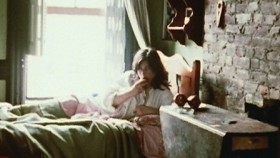A non-urban selection, indeed. Most of the films in the national competition took place outside the big cities. And very often in Siberia. Films about people and culture, clashes between indigenous people and the so-called civilisation like in ”The Land Where Mammoths Slumber” (Eva Belova), that is an informative documentation about the Nenets culture, where the reindeers have almost disappeared, but where they still have their ”chums”, tents, now often with tv and internet. A man with a foot in both cultures is the one conveying the dilemmas they face, another one is an artist, a charismatic man, who claims that bureaucrats are the worst enemies for the nenets, ”human rats”! The film stays on the informative level far from the artistic ambition that we have seen from the hands of Estonian Mark Soosaar.
I am afraid that I don’t have many fine words for another film far away from big cities – ”Kamchatka – the Cure for Hatred” (Yulia Mironova) that follows a war correspondent, who takes refuge in this far east island filming himself and his spouse, they get a child, she returns to Moscow, he stays and one year later he is back in war in Syria! I don’t see or hear reflections on the traumas he is to have brought from the Chechen war. The title remains a postulate.
Talking about war – ”Edges of Memory” (Anton Moiseenko) is a film with
talking faces, war veterans, who remembers, personalities, who are good to watch and listen to, an absolutely non-heroic story, and yet why does the director include a young, mostly smiling soldier of today, who says nothing but pops up once in a while… is it to say that this is what is waiting for you? A forced element into the narrative, I think.
Also disappointing for me – more so as I am a big fan of what Marina Razbezhkina and her film school is doing – was ”Yamaha” (Inna Omelchenko) about the young man who can not find a place to perform his passion, because he is making noise with his yamaha… the film lacks energy, I find it flat, sorry. A pity as my first note on the paper was: Finally a film about young people!
AND NOW TO THE ONES I LIKED…
First of all Tatyana Soboleva’s ”Siberian Floating Hospital” (PHOTO) that I first met at the Baltic Sea Forum in Riga 2011 and that I now saw on the big screen that ”liked” the beauty of the images, the warm and respectful approach to the characters on the ship, these fine women, first of all, who are away from home for six months to travel to remote areas to offer the locals medical assistance. Soboleva has filmed for years, you can see that – time is quality.
But also ”In Search of Happiness” by Dmitry Sidorov and Svetlana Demidova about the couple, who ”left the big city in search of peace, solitude, and freedom” – almost 30 years ago. They have bees, goats – who have names – and themselves, and a son, Ilya, and that is where the trouble begins. Ilya takes beautiful photos, he helps on the farm, but he also has a girl friend, with whom he skypes and with whom he would like to live, much to the disappointment of especially the mother, who thinks that Katya, the girl in question, should just give up her ideas about studying and come and live with them. There is a great scene, where the three of them argue about this theme; it’s not difficult to have sympathy for the grown-up young man, who has no future with mum and dad in this far-away dream of their’s. Producer Viktor Skubey told me that the budget they had allowed for two weeks of shooting and three weeks of editing. On that background, a very fine result it is for a 70 minutes long film.
And Olga Maurina succeeded to create atmosphere and catch situations in ”Sons” about boys, orphans, in a foster family. There is a fine observed intimacy in the scenes and she dares to have long scenes where nothing happens – contrary to the wonderful symbolic scenes, where the new boy Igoryek learns – by himself – to bike. Touching and funny at the same time. 40 minutes long, fine for a documentary like that.
Form, think about form, how do you want to convey your theme as a film – Elena Laskari has done so with her ”Ceremony”, in stylistical terms the only original film (56 mins.) in the Russian competition at the Message2Man 2015. Boris Borisovich, the boss of the posh crematorium is the character of the film, the one who calls the funeral ceremony a theatre play, where you have to create a scenario of your own leaving this earth. And the director follows him superbly in this point of view. The film is staged as the procedures are, the clothes to wear by the performers of the ceremony intercut with small episodes where the relatives have to confirm that the name on the urn with the ashes is the right one. Some take the urn to have the ashes spread somewhere. There is also a sequence where you can test how it is to lie in a coffin and be lowered down in the ground! – And the question is put: Do you want to be beautiful in the coffin? You can of course have a pre-paid contract set up, the music to be chosen, the text to be read, all it tested, also in new uniforms. ”When children die”… is there as well in a film that is fascinating to watch, a theatre performance indeed at a special, rich place in Russia.
http://www.message2man.com/en/



